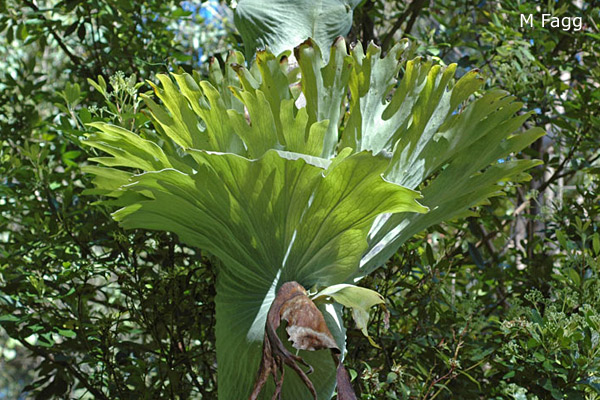General Description:
Platycerium is a genus of about 18 species of ferns, four of which occur in eastern Australia. Two, the elkhorn (Platycerium bifurcatum) and the staghorn (Platycerium superbum) are well-known in cultivation.
A fully grown staghorn fern can make an outstanding specimen, as imposing as any Australian plant in the garden or bush. Staghorns are generally epiphytic (growing on trees), or occasionally lithophytic (growing on rocks). These ferns have broad nest fronds, or sterile fronds, to 60 cm diameter, which grow and embrace the host and from a humus-collecting bowl, which can reach impressive dimensions of 1 metre across. The laminae of these fronds are erect and simple with deeply lobed upper margins. Fertile fronds are quite different in appearance, being broad at the base and hanging down from the plant, with forked laminae up to 200 cm in length and 2-6 cm wide. Brown sori, which contain spores, occur on the underside of the fertile fronds.
In nature, these ferns often grow high up in trees, where they receive much light filtering through the canopy. Similarly, plenty of light is important for good growth in cultivation and dense shade is resented. Filtered sunlight with some humidity is best. Some protection from drying wind is important, however, overwatering must be avoided. If the peaty centre remains continually wet, rot may occur and eventually kill the fern. Soaking intermittently, say, once weekly (but also depending on rainfall) is best. Fertilise with liquid organic fertilisers and sprinkle about 5g slow release fertiliser capsules into the bowl at intervals. Every few months place small pieces of aged hardened cow manure in the bowl. Staghorn ferns appreciate a slihtly acidic environment and some growers find the remnants of a teapot emptied into the bowl to be helpful!
Propagation is by germination of spores (see “Australian Plants online” March 1999 issue for simple propagation methods).

Platycerium superbum
Photo: Murray Fagg – Australian National Botanic Gardens
 Australian Native Plants Society (Australia)
Australian Native Plants Society (Australia)













